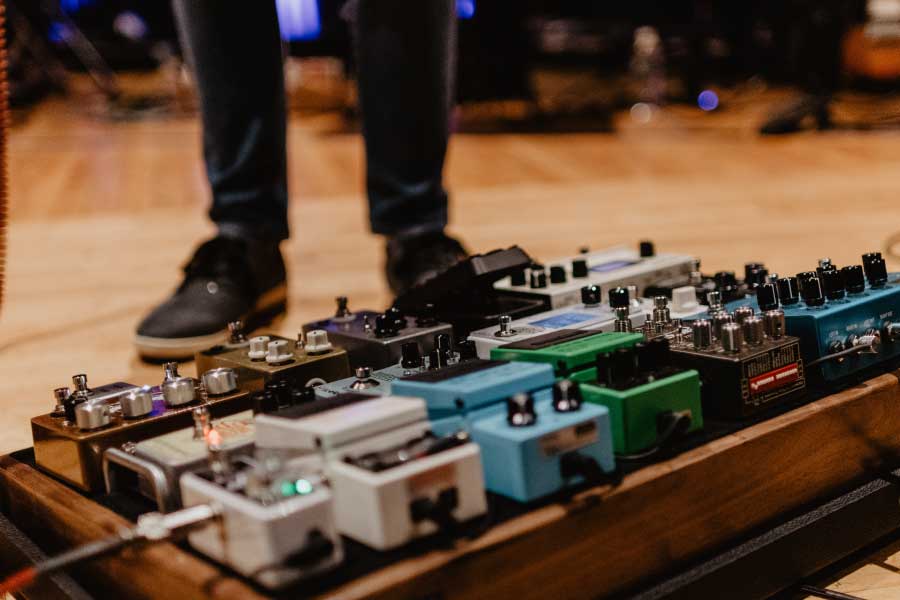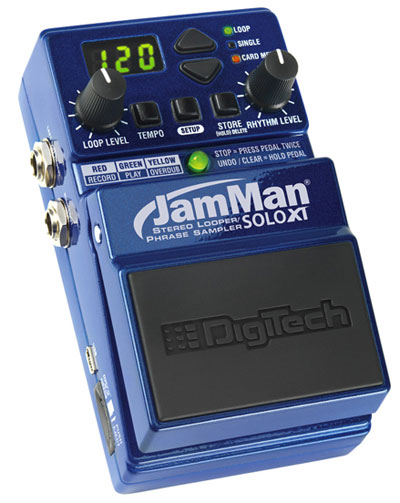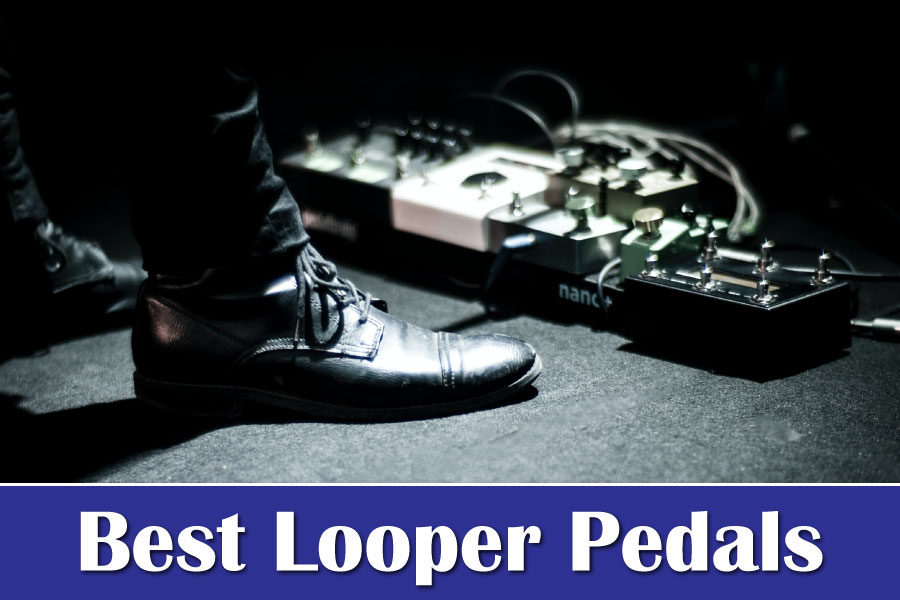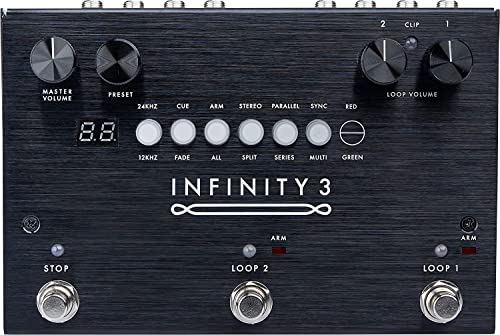What is the best looper pedal for guitar in 2022? On this page we provide a guide to loop pedals, including: what is a looper pedal, looper pedal controls, how to use a looper pedal, and a roundup of the best loop pedals available in 2022.
Page Index
- What Is A Looper Pedal?
- Best Loop Pedal: Our Top 3 “Quick Picks”
- How Do Looper Pedals Work?
- What Can I Use a Looper For?
- Where Should I Put A Looper Pedal In My Pedal Chain?
- What To Look Out For When Purchasing a Looper
- The Best Looper Pedals 2022 Round-Up
What Is A Looper Pedal?
A looper pedal allows you to record a section of music and play it back in real time. The music you recorded will then continue to play in a continuous “loop”. You can either use this loop as a backing track, or add further overdubs in order to build up a complex, multi-layered arrangement.
Looper pedals are popular among solo guitarists and singer-songwriters, who use their loopers to create arrangements that include riffs, chords, and melodies.
Some looper pedals even come with drum patterns and bass lines, providing you with a complete “band in a box”.
Two prominent guitar players who use loop pedals in a live setting are Ed Sheeran and Gerry Cinnamon. These and other guitarists have raised the profile of the looper pedal in recent times and today there are even looping guitar competitions!
Whatever style of music you play, a looper pedal provides you with a whole world of creative possibilities, from soloing over jazz chord progressions to creating pop songs. Unlike other guitar pedals, you might come to regard the looper as a new instrument rather than a simple effect!
If you want to see a true guitar virtuoso making the most out of a looper pedal, check out this video from the loop station world championships:
On this page, we’re going to look at the best loop pedals on the market at every price point. If you’re looking to pick up a looper in 2022, look no further than our handy guide.
Best Loop Pedal: Our Top 3 “Quick Picks”
You’ll find a list of good looper pedals further down the page, but for those in a hurry here are three pedals you might want to check out:
TC Electronic Ditto
- 5 minutes of loop time, unlimited overdubs and undo/redo
- Designed by guitarists, for guitarists
- True bypass and analog-dry-through
- The item Ditto Looper requires a 9 V power supply providing 100 mA or more (not supplied).
The TC Electronic Ditto is a powerhouse pedal with a single footswitch and a modest price point, perfect for dipping your toes into the world of looping.
View the TC Electronic Ditto at AmazonEHX Nano Looper
No products found.
The EHX Nano Looper offers a little more versatility and functionality in a Phase 90-sized chassis.
No products found.Boss RC-600
- Stereo Loop Pedal with 6 Stereo Phrase Tracks
- 2 XLR Microphone Inputs with Phantom Power
- 2 Stereo Instrument/Line Input Pairs
- 99 Phrase Memy Presets
- Rhythm Guide
The Boss RC-600 is the godfather of all loopers, with plenty of switches, multi tracks, and even the option to loop your vocals if you’re singing.
View the Boss RC-600 at AmazonHow Do Looper Pedals Work?
Loop pedals record a segment of audio, then play it back in a continuous loop. The user can then use the repeated loop as backing, or add overdubs to the original loop.
Loop pedals are a progression of the technology used in the digital delay pedals of the 80’s. These units were extremely popular among guitar players wanting echo effects without the need to cart around bulky, expensive tape echo units like the Echoplex.
Instead of repeating a phrase that gets progressively quieter (à la a delay pedal), a looper pedal loops the recorded phrase without fading.
Typically, a loop pedal will have one or more footswitches for controlling recording / overdubbing and playback.
Basic operation of a looper pedal involves pressing a pedal down once to start recording, and pressing it again to stop. Usually, the phrase will then automatically start to repeat ad infinitum, allowing you to play over the top of the recorded sound.
Depending on the model, another pedal press may be required to record an overdub, which will then continue to play along with the original loop. Usually, you’re free to record as many overdubs as you need. It’s easy to get carried away and build up a solid wall of sound!
(If you’re not happy with your performance, you’ll usually be able to delete the last overdub you made.)
What Can I Use a Looper For?
Most guitar players use loopers for live performance and practice. Loop pedals are also useful tools for writing songs and jamming.
Some players, when working on a song idea, like to record it as they go and play it back. This allows for immediate, live recording and the opportunity to listen to a part rather than playing it.
You can also improvise over a cool chord progression you’ve come up with, or harmonize with yourself like Brian May or Thin Lizzy.
Some loopers also offer you the chance to save and export your loops, which is handy when you’re writing songs on the go away from your home recording setup.
Sometimes, you just need to jam over a tasty rhythm guitar part. That’s where loopers come in really handy. You can just lay down a backing track for yourself, loop it, and have a chord progression to play over.
Guitarists, particularly soloists and those in a band without another player, can use loopers live, too. With a looper pedal, you can play multiple parts, counter-melodies, or even stack multiple loops on top of one another.
Check out Scottish singer-songwriter Gerry Cinnamon using a looper live to great effect in this video:
Where Should I Put A Looper Pedal In My Pedal Chain?
The most common answer to any iteration of the pedalboard placement question is “try different spots and see what works”.
A more helpful answer is to place your looper at the end. That way, it will capture any effects you have in the mix. That way, you can record a clean rhythm part and solo over it with an overdriven lead sound (for example).

Some loopers have stereo input and output to allow you to include or exclude other parts of your signal chain, too.
What To Look Out For When Purchasing a Looper Pedal
Features
If you’re looking at getting yourself a looper pedal, you’ll want to take a few things into consideration.
First and foremost, what do you need the looper to do? Do you just need simple loops for playing and singing over, or do you want to create complex, multi-layered and multi-sectioned arrangements for professional performances?
Some looper pedals, such as some of Boss’ high-end models, include effects, rhythm patterns, and even quantized timing. These features allow you to create impressive-sounding arrangements, but perhaps at the cost of some of the immediacy of a simpler model.
As with all gear, there’s no point in paying for features you’ll never need!
Complexity

Another consideration is how much of a learning curve you’re willing to submit yourself to.
Some loopers, like the Ditto, use a single footswitch to control recording, playback, and deletion. Others, as we’ve seen, have multiple footswitches and countless additional functions.
You may think that a compact pedal is easier to learn than a larger model, but this is not always the case. In our experience, single-pedal loopers can be less intuitive than multi-pedal units.
This is because single-pedal loopers often differentiate between long, short and double pedal presses, with each performing a different function. This can be more confusing than having a distinct pedal for each function.
Some single-pedal loopers have the option of attaching an additional pedal to handle certain functions. This gives you the option of expanding your setup if looping becomes a big part of your sound.
Size
If you’re serious about getting into guitar loops, you’ll want to make sure the size of the looper suits your needs. Smaller pedals are best for those looking to add a looper to their existing pedalboard, but you might prefer to build an entire rig around a large, high-end looper.
Price: How Much Is A Guitar Looper Pedal?
You can pick up a cheap looper pedal for under $100, but you probably don’t want to spend much lower than that. Some high-end loopers will set you back over a thousand dollars, but if you’re just a beginner it’s best to keep to a lower budget.
Something around the $100-200 mark will get you a workable looper that you can rely on for years to come. Increasing your budget will increase your options to loopers with extra switches, effects, rhythm patterns, and all sorts of extras.
As always with guitar gear, you get what you pay for!
The Best Looper Pedals 2022: Round-Up
Here are our favorite loopers on the market in 2022, from simple beginner designs to bigger machines aimed squarely at Jedi-level guitar loopers.
TC Electronic Ditto
- 5 minutes of loop time, unlimited overdubs and undo/redo
- Designed by guitarists, for guitarists
- True bypass and analog-dry-through
- The item Ditto Looper requires a 9 V power supply providing 100 mA or more (not supplied).
The Ditto is one of the most widely used loopers. Its single footswitch is plenty for most guitarists, although using it to start, stop, and erase loops might be overwhelming to start with. It’s relatively cheap, reliable, with great sound quality. Simple and effective.
EHX Nano Looper
No products found.
The EHX Nano Looper offers 360 seconds of looping time, plenty for your to build solos and chords. You can also divide these into up to eleven different loops to cover different sections. Its single footswitch is intuitive to use, and its pedalboard-friendly footprint makes it a favorite for active gigging musicians.
Boss RC-600
- Stereo Loop Pedal with 6 Stereo Phrase Tracks
- 2 XLR Microphone Inputs with Phantom Power
- 2 Stereo Instrument/Line Input Pairs
- 99 Phrase Memy Presets
- Rhythm Guide
The RC-600 is arguably the most advanced looping station in the world. You can capture multiple mics and instruments. It offers six stereo tracks, nine assignable footswitches, and onboard effects. Not for the faint-hearted, but it’s a serious looper from a major brand.
Boss RC-5
- 13-hour Stereo Looper Pedal with Col LCD
- Onboard Rhythm Tracks
- USB Impt/Expt
- MIDI I/O
The Boss RC-5 is not just a looper. It’s a drum machine, too! It has plenty of onboard memory (enough for 13 hours’ worth), 32-bit processing for awesome audio quality, and the rugged, reliable construction we’ve come to love from Boss. Its 57 built-in drum parts will give you an intro to the band-in-a-box experience of live looping.
Pigtronix Infinity
- Dual Looper Pedal with Stereo Ins Outs
- 24-bit/48kHz Recding
- 3 Hours of Recd Time
- 50 Recallable Loops
The Pigtronix Infinity offers multiple switches, USB loading, variable speeds, and plenty of functions. It only offers you two parallel loops, though, so it may not be as useful for live application. As a songwriting tool, and at a competitive price, it’s pretty handy.
Electro Harmonix 720 Looper
- 10 independent loops
- Undo-Redo, Reverse and ½ Speed Effects at the touch of a button
- High-quality, uncompressed audio, 24-bit A/D/A converters plus 44.1kHz sample rate
- Stereo in/out for enhanced usability… record two instruments at once
- Silent footswitches
Big brother to the Nano looper, this stereo looper has an extra footswitch, onboard effects, and even a fadeout mode. It’s a little finicky for live use compared to the Nano 360, but it’s very useful for most looping applications.
Digitech Trio+
- The TRIO+ is a simple-to-use guitar pedal that listens to the way you play and automatically generates bass and drum parts that match your song. Just plug your guitar into the TRIO+, press the Band footswitch to teach the TRIO+ your chords and rhythm, then press the Band footswitch again to start playing with your own personal band!
- The TRIO+ reads your guitar signal in real time and creates Bass and Drum tracks automatically.
- TRIO+ offers guitar looping in addition to Band Creator Bass and Drum tracks.
- The TRIO+ provides 12 music genres to choose from including: blues, R&B, rock, alternative rock, metal, pop, electronic pop, hip-hop, country, folk, latin, and jazz.
- Adjustable tempo with Audiolastic time stretching and quick selection of alternate time interpretation.
Digitech were among the pioneers of the new wave of loop pedals with their popular JamMan range. Sadly, these are no longer available, but the company still caters for loop fans with their amazing Trio+, which is not only a traditional looper, but a complete "band in a box".
This is the sort of looper you could build a rig around as a songwriter. It allows you to record a loop and instantly generate a bass and drum backing track, modifiable to fit a number of styles. If your parts are simple enough, and your PA can handle the output, this might even be worth using live to build your own backing tracks on the fly.
This intelligent gadget can even transpose your loops into different keys!
TC Electronic Ditto X2
- Dedicated Start/Stop Button
- Loop Import/Export and Backing tracks
- Looper effects: Stop, Reverse and Half Speed
- style: Ditto X2
The X2 effectively builds on the Ditto’s existing functionality by offering a few extra bells and whistles. An additional footswitch, two effect modes, stereo in/out, and the ability to save and load loops via USB. It’s effective for live use as well as simple home applications.









